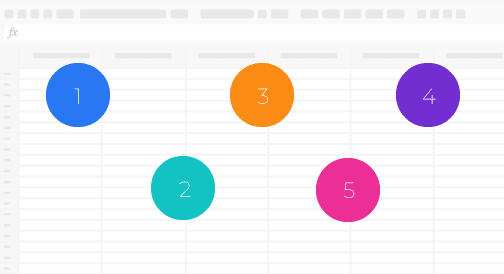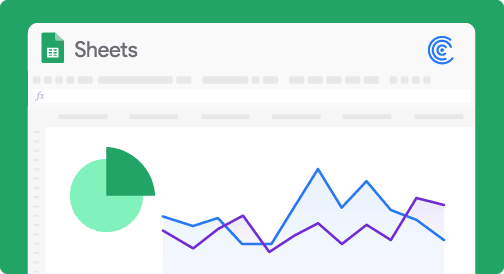Think about your company’s software stack. If you had to guess, what would you say are the most used software for colleagues across your organization? You may say, Outlook, Gmail, or Slack; because it is easy to forget the dark horse — spreadsheets.
Microsoft Excel, the most widely used spreadsheet software, has 750 million+ users. Google announced its G Suite (which includes Google Sheets) surpassed 2 billion monthly active users. If a conservative 25% of those customers use Sheets, that’s 500 million users. To give you some perspective on just how massive these numbers are in terms of software usage, consider the active user base for some of the most prominent SaaS tools:
- Salesforce: 3.75 million
- Slack: 12 million
Spreadsheets are ubiquitous and their usage and use cases are staggering. They’re the universal language of business. Practically everyone is familiar with them so there’s no onboarding required for this incredibly powerful tool. Reporting and analysis is a key use case of spreadsheets. Even companies that invest heavily in expensive BI tools find their employees reverting back to the trusted tool. The same story repeats for a lot of SaaS software. Their biggest competitor is rarely another SaaS tool, but instead, spreadsheets.
Why is one of the world’s most widely used software tools so disconnected?

Spreadsheets are not just simple, flexible and ubiquitous. They are insanely powerful tools. It is a programming tool in its own right, allowing technical and non-technical users alike to code advanced logic to extract insights from data and to codify business processes.
But there is one giant problem. This uber-powerful tool works off of static, stale and manually imported data. Why? Because spreadsheets are inherently flawed when it comes to data connectivity. While it has become much easier to collaborate with our teammates over spreadsheets, the data that powers the analysis has to still flow in manually.
Today, most systems in a company work together with inter-operation via APIs, connectors and plugins. Spreadsheets, however, work as a tool that is completely isolated and disconnected from the rest of the company systems.
No wonder, the running joke: “Export to Excel is the third most common button in data and business intelligence apps… after OK and Cancel.”
Here are some of the most glaring pitfalls of spreadsheets in their current state:
1. Data is stale
Data is changing real time. Companies are spending a lot of resources on staying on top of this. Yet, most users analyze data by downloading — or even manually copying and pasting — to a spreadsheet! The data the user is working with is immediately outdated the moment it leaves the source system. This puts your business at a perpetual disadvantage. You can run all the analyses you want, but if you’re not working with real-time information you don’t truly know what’s happening.
As we work with an early group of teams, we have seen first-hand how real-time data can change types of analyses people start to build in their spreadsheets.
2. Data accessibility
Spreadsheets are an empowering tool, especially to non-technical employees, but only if employees can get to the data. In most organizations today, the data is accessible via overwhelmingly complex BI tools, or cumbersome reporting interfaces of myriad SaaS tools, or requires knowledge of SQL. This hinders the ability to answer questions quickly, and often forces dependence on others to get relevant data.
The ability for users, often at all levels of the company, to be self-sufficient routinely comes up as the key benefit from our early adopters.
3. No single source of truth
When spreadsheets are not directly connected to the company systems, every person can have their own version of the data and will make their own set of manipulations and clean-ups. With no clear understanding of the data’s origin, it is impossible to know if it’s accurate or not.

Stop exporting data manually. Sync data from your business systems into Google Sheets or Excel with Coefficient and set it on a refresh schedule.

4. No automation
In their current state, spreadsheets are powerful yet time consuming. Users spend hours every week manually updating their data, exhausting valuable resources while at the same time leaving it susceptible to errors. This no-automation time constraint also forces them to choose where they focus their efforts, leaving a slew of missed opportunity analyses on the table.
Why should your spreadsheet analysis, model, or dashboard not keep itself up to date? You have already written the “code”.
Despite these host of constraints, business users still flock to spreadsheets. And that ain’t stopping folks! So just imagine just how much more powerful this ubiquitous tool could be if the disadvantages were turned into its advantages. Enter Connected Spreadsheets.
Unleashing the power of spreadsheets through connectivity
Spreadsheets are arguably the most used business tools in the world. It’s time to transform their role from an ad-hoc analysis tool to a powerful programming tool that teams can feel confident to rely on for real-time, automated analyses.
We are embarking on the mission to supercharge the tool our teams already live within. We see massive unrealized potential in how spreadsheets are used today and what they could be. With over a billion people who are familiar and conversant with spreadsheets, this is one of the highest impact undertakings in the business software world today.
Bridging the gap between where the majority of your company sits — spreadsheets — and the rest of your company systems will empower your teams to become self-sufficient data analysts and automation ninjas, all the while using the tool they already know and love. It is the power and unrealized potential of these spreadsheets that lights up our vision.
![]()





